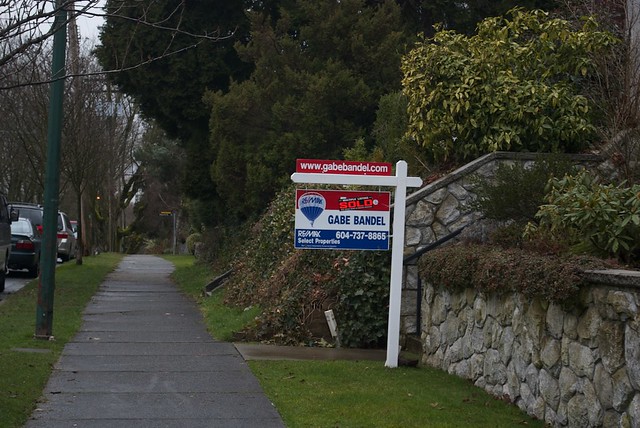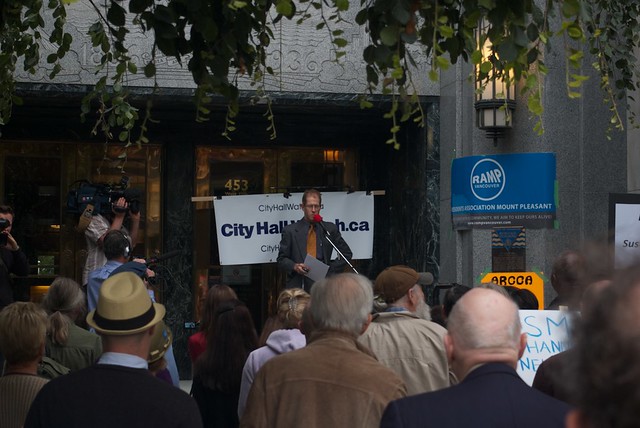Although the Mayor’s “affordable housing task force” is unlikely to drive real change, it could have the positive impact of triggering public debate around the mechanisms and causes of Vancouver’s permanent housing bubble. Much of the conversation, like the task force itself, includes only elites — a monologue of the 1%. The Mainlander‘s COUNTERPOINT series aims to take the conversation out of the board rooms.
Author: Sean Antrim
Vancouver’s civic election on Saturday has brought us a new City Council. But as the five million dollar campaign fades, we should take a look at what this ‘new’ council wants to do. By electing Gregor Robertson and the Vision slate, voters have decided to stay the course on a path started in 2008 — but what exactly is the course?
Though progressives might feel relieved for keeping out an NPA majority, we must remember that Vision has and will implement neo-liberal policies — many of them NPA policies from the 2005 – 2008 term under Sam Sullivan. Residents will have to mobilize against council, or else get more of the same. Over the past three years we saw the donning of Vancouver as the City with the lowest businesses taxes in the world, matching an increase, not a decrease in homelessness, and an almost 20% increase in housing prices last year alone. These losses can be weighed against the positive implementation of the unjustly controversial backyard chicken coops, bike lanes, and food carts. While we will be safe from the NPA’s street-car, we will most certainly not be safe from Vision’s land-use policy predicated on eviction and demolition of affordable housing.
Because council has the same developer-funded majority it has had over the past two terms, we can look at the past six years to loosely predict what we will see on council over the next three:
a) Wedge issues
To create the illusion of democracy and choice, NPA and Vision will have to chose a set of wedge issues, which will redirect the discussion of civic politics away from issues onto superficial gossip and ruling-class infighting. Differentiation will have to take place in lieu of actual difference. Over the past three years, we’ve seen the two developer parties focus on personal smears, bike lanes, $1,000 environmental projects, or most recently, the street-car. Many progressives stand with Vision on these issues, but they are only a distraction from the municipal government’s main purpose, which is to regulate land-use and facilitate affordability.
b) Gentrification
We will see much more displacement in Vancouver, especially the Downtown Eastside. Vision Vancouver wants to build condos in the Downtown Eastside as part of their ‘ten-year housing plan’. The only way they can do this without subsidizing (which they are against) is to build in low-income neighbourhoods where the land is least expensive. Even when there was only one NPA councillor, Vision Vancouver embraced the NPA’s plan to rezone the DTES for condo towers. Already, Vision is set to approve a proposal for a 17-storey condo tower for the corner of Main and Keefer. The developer is Westbank Corp, which held a huge fundraiser for Vision during the election. The two new NPA councilors will agree with Vision’s plan to increase condo development in this low-income neighborhood, while COPE will have to make their critique of gentrification from the sidelines
We will also see large condo towers popping up throughout East Vancouver, justified as part and parcel of the NPA’s EcoDensity program, which Vision Vancouver has adopted since 2008. Massive developments in low-income neighbourhoods are the most profitable form of real-estate development, and are therefore the most desired by developers. In anticipation of this gentrification, shops will raise their rents and evict long-time businesses. This can already be seen on Main Street, along Kingsway, in the Downtown Eastside, and elsewhere.
c) Evictions
Gregor Robertson and Vision Vancouver have said on several occasions that they are unable to stop evictions. But the truth is that they do not want to stop them, because their housing policy is literally dependent upon evictions. To build affordable housing without subsidizing it, you need to evict low-income tenants — that is the only way. Vancouver has “rate-of-change” bylaws that prevent conversion of rental to condominiums, but do not prevent conversion from low-income rental to medium or high-income rental. Vancouver has created its own portmanteau for this ongoing process: the ‘renoviction.’ This is the simple process of landlords evicting tenants to increase rents further than inflation-plus-2%.
The Mainlander’s Sean Antrim sat down with their Mayoral candidate Randy Helten of Neighbourhoods for a Sustainable Vancouver (NSV) to talk about affordability, accountability, the arts, and Vancouver’s future. It is a tall order for a political party that does not receive corporate and developer donations to get candidates elected. NSV has been fighting an up-hill battle.
Sean Antrim: What amount of development do we need in Vancouver right now? And the reason that I’m asking this question is because many people, and the mainstream press, have criticized Neighbourhoods for a Sustainable Vancouver as being NIMBY-based. A lot of journalists have been around for a while, and in the 1990s with Gordon Campbell, NIMBY-ism was quite a problem.
Randy Helten: To tell you the truth, I don’t know the answer. In fact, I don’t think anyone knows the answer. The people who know the answer are concealing the answer. Because the City has removed from public access numbers that show the current zoning capacity. It used to be up and available, but it’s gone now. My understanding is that Professor Patrick Condon at UBC has done some studies, and he’s saying that for construction within the current zoning, the capacity for additional population density is enough for decades into the future. Construction could happen without any rezoning, to fill all of the incoming population.
The City has these numbers, and in January of this year [COPE Councilor] Ellen Woodsworth put forward a motion that was passed, according to which the planning department was supposed to release the numbers of zoning capacity to council some time in February. It’s off the map. Despite repeated requests there’s been no response out of the planning department. So no one knows the answer publicly. The information is concealed. My suspicion is that if you take the West End, for example, I think in the current zoning, without rezoning, we could accommodate another 5,000 people or so. That’s just a sense, because I know the areas that are zoned right now for six stories that are currently two stories. If you take the average of all that and you look at a long term thirty-year plan or a hundred-year plan, and look at the land area in the West End and long term population goals — steady growth, not too extreme, not too rapid — the West End could accommodate several thousand more people.
Sean Antrim: That’s the way most cities do rezoning — blanket rezoning — which is doing an entire neighbourhood at a time. Why do you think we have so many spot rezonings in Vancouver?
Randy Helten: My understanding of the dynamics is that a spot rezoning allows exceptions to happen within the existing zoning. In many cases it offers huge returns to the owner of those specific spots. If you go to the old adage “follow the money” and look at who’s making campaign contributions to our elected officials, it makes sense. They’re making the campaign contributions, the officials get into power, and they have control over land use decisions. They’re supposed to regulate the land on behalf of the entire public and balance all the interests of all of the stakeholders. Both Vision and the NPA as organizations are incapable of avoiding undue influence from that private money, and that’s what we’re seeing as the results of their decisions.

Here Andrew Witt and Sean Antrim of The Mainlander interview Sandy Garossino, who is running as an independent candidate for Vancouver City Council this November 19.
Andrew Witt: You launched your campaign in the Georgia Straight attacking the affordability crisis in Vancouver. At the Mount Pleasant all-candidates, every candidate from every political party gave lip-service to this issue. I think that everyone recognizes that there is an affordability crisis in the city. In 2008, Vision Vancouver was elected on a platform that would address housing, homelessness and the affordability crisis, but we all know they have done little to tackle the problem. How will you address this issue, and what distinguishes your platform from that of Vision Vancouver?
Sandy Garossino: Almost everyone that I have heard discuss this sees the affordability issue. I’m talking here about broadening this beyond homelessness and subsidized housing, but also market housing for the average working person. Almost everyone who talks about this, talks about it in the simple supply and demand equation, and their point is to increase supply. Because I deal with Asia, I understand capital markets in Asia, and I have dealings there, this seems to me to completely miss the true nature of the issue and the challenge that we confront. Just to give you a little bit of a background, our median income levels in Metro Vancouver place 20 out of 28 urban regions in Canada. Our median income levels for 2010 were below Sudbury, Windsor and St. John’s Newfoundland. We have the highest real estate prices in Canada, relative to median income. We have almost the highest real estate in the world. Relative to median income, we are 56% higher than New York City and 31% higher than London, so there’s clearly a serious distortion in the market. One of the first challenges we have is we don’t have the data. We don’t have information that can pin-point exactly what is going on and the extent to which capital is entering, and the extent to which that capital is non-resident, and how much that is affecting the market. We need to know a lot more than we do. But based on anecdotal information, which is turning out to be corroborated in news reports, it looks like global capital is having a massive impact.



